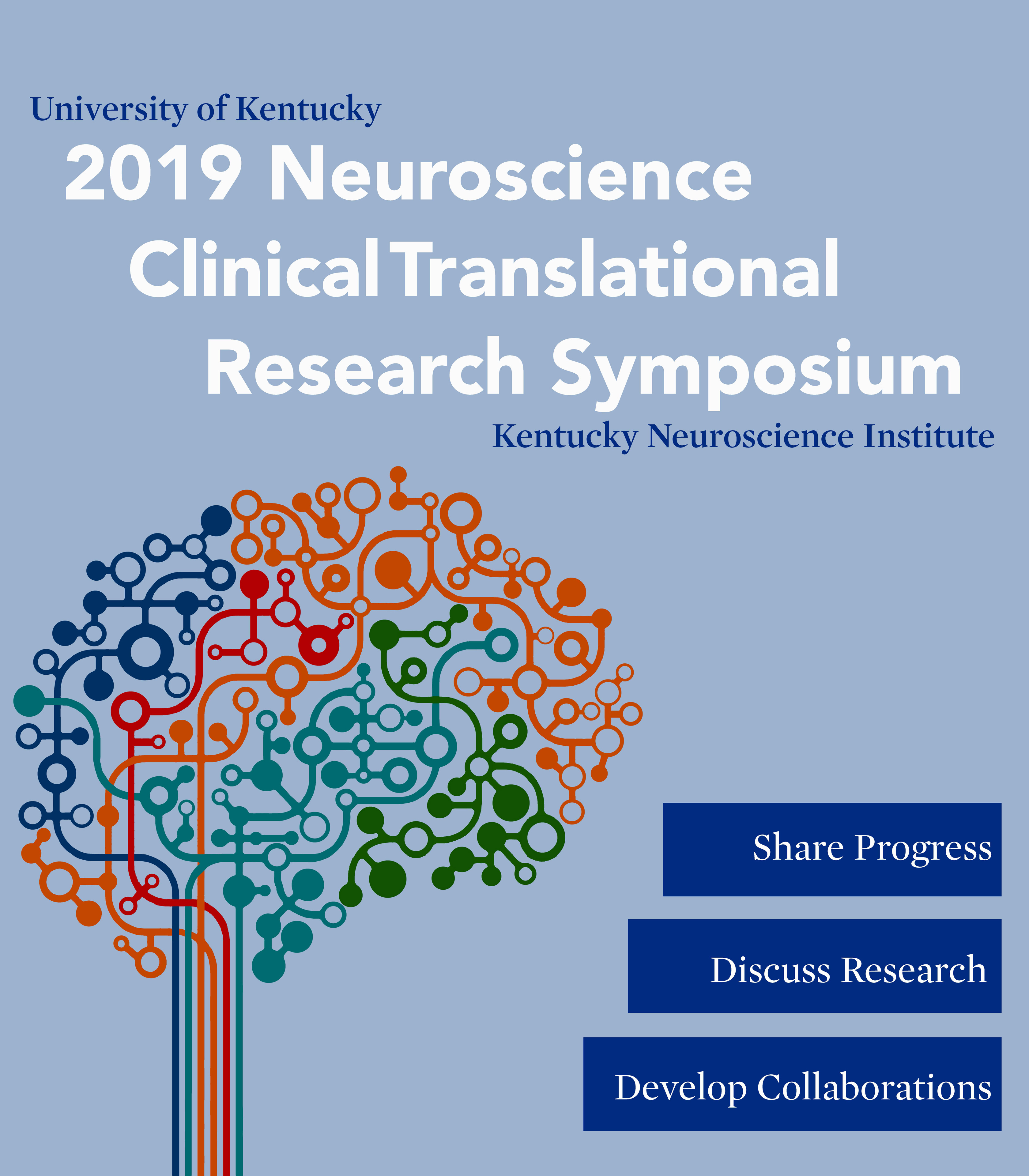4th Annual KNI Clinical-Translational Research Symposium
The 2019 Kentucky Neuroscience Institute Clinical-Translational Research Symposium is a daylong event that will provide the opportunity for basic, translational, and clinical neuroscience investigators including trainees, laboratory and program directors throughout the university to discuss their work, share progress, and develop collaborations. The 4th annual event is scheduled for October 4, 2019 in Karpf (PAV A) Auditorium, with the first poster session beginning at 8am.
Presenters can be undergraduate, graduate students, medical students, postdocs, residents, fellows, faculty, or physicians.
The purpose is to share information within the wider University of Kentucky community, generate feedback, and create collaborations. The following are acceptable for submission: abstracts previously presented at national meetings; both clinical research and basic-translational neuroscience-related; works in progress may be submitted as well. The symposium will include a scientific poster session and multiple theme-based platform sessions, each with short, 10-minute talks selected from abstract submissions. Please join your colleagues for this terrific event!
Cognitive Behavioral Abstracts
Stress Effects on Simple Learning and Memory: A Rodent Model
Association of Multiple Proteinopathies, Cognitive Decline, and Dementia in a Community-Based Autopsy Cohort
The Effects of βeta-hydroxybutyrate (BHB) on Cognitive Performance in Healthy Populations
CSF Amylin – Effect Modifier of the Aβ-AD Relationship
Amylin Dyshomeostasis Disrupts White Matter Structural Integrity and Modulates Amyloid Composition and Pathology Distribution
The Role of elF5A in TDP-43 Pathology in FTD; The Tip of the Iceberg?
Feasibility of Dynamic Sleep Enhancement in a Mouse Model of Alzheimer's Disease
Improving use of MoCA in Assessing Cognitive Impairments in Older Adults with Low Formal Education
Bisphenol A: A Trigger of Neurovascular Dysfunction and Cognitive Decline in Alzheimer's Disease?
Epilepsy Brain Metabolism Abstracts
Discrimination of High Frequency Oscillations from Sharp Transients in the Electrocorticogram of Patients with Refractory Epilepsy
VA-1221: Testing a Novel Pompe Disease Therapy in Lafora Disease Mouse Models
Toward High-Throughput, Non-Invasive Seizure Detection Using Piezoelectric Motion Sensors
Membrane Palmitoylated Proteins Regulate Synapse Density and Function in C. Elegans
Laforin Nanobodies for the Understanding and Treatment of Lafora Disease
Movement Neurodegenerative Abstracts
Neurotransmitter Levels in PFAS-Treated Northern Leopard Frogs
Neuro Trauma Abstracts
Understanding Interleukin-1 Receptor 1 Localization After Traumatic Brain Injury
Examining CD44 as a Novel Marker for Reactive Astrologiosis Following TBI
Mitochondrial Uncoupling Prodrug Improves Mitochondrial Bioenergetics, Cognitive Outcome and Tissue Sparing After Traumatic Brain Injury
Investigating the Link Between Cervical Spinal Cord Injury and Acute Lung Injury
Longitudinal Analysis of Gut Microbiome Composition After Experimental Cervical Spinal Cord Injury
Photo- and Phono- Sensitivity Following mTBI is Associated with Emotional Distress Identified in the Beck Youth Inventory - 2nd Edition for Children
Effects of Repeated Concussive Brain Injury on Progression of Tau Hyper-Phosphorylation
Neurophysiology Abstracts
Ruling out PGRP-LC and PGRP-LE Peptidoglycans Receptors in the Response to Bacterial Endotoxin LPS in Larval Drosophila
Pharmacological Profiling of Stretch Activated Channels in Proprioceptive Neurons
Fibroblast Growth Factor 19 in the Dorsal Vagal Complex Alters Excitability of Dorsal Vagal Motor Neurons and Lowers Blood Glucose Concentration
Neurorehabilitation Abstracts
Neural Correlates of Grade Movement for Brain-Computer Interfaces
Impact of Corticospinal Integrity on the Effects of tDCS
Neruovascular Stroke Abstracts
Can't Breathe, Can't See, Can't Think: COPD Increases the Risk of Posterior Reversible Encephalopathy Syndrome
Combination of DMH1 Treatment and Intra-Arterial NSCs Delivery Improved Ischemic Stroke Outcome
Noninvasive, Noncontact Optical Imaging of Cerebral Blood Flow in Rats
Impact of Substance Use Disorder on Stroke Outcomes
A Wearable Optical Sensor for Noninvasive and Simultaneous Measurements of Tissue Blood Flow and Oxygenation
Protocol to Isolate Lymphocytes for Flow Cytometry from BACTRAC Samples
Prediabetic Hypersecretion of Amylin Alters Oxygen Sensing and Accelerates Aging
Diabetes-Related Amylin Dyshomeostasis Impairs Amyloid-β Clearance by miRNA-Mediated LRP1 Downregulation in Brain Capillaries
Circulating microRNAs as Potential Biomarkers for Assessing Vasospasm Risk Following Aneurysmal Subarachnoid Hemorrhage
Activation of JAK2/STAT1 Pathway by IFN Gamma Induces CXCR3 Signaling and Inflammatory Response by Mouse Cerebral Endothelial Cells and Astrocytes
Inhibition of BMP-Smad1 Signaling and Neural Stem Cell Transplantation for Cerebral Ischemia-Reperfusion Injury of Mice
Other Topic Abstracts
Use of Marijuana and Narcotics on Emotion Recognition
In Vivo Monitoring of Intracellular pO2 in Response to CAR T Cell Immunotherapy Against Glioma
Identifying Neural Correlates of Nicotine Withdrawal in Mice: The Neuregulin Signaling Pathway
Optimizing Methods for Light-Based Production of BDNF After Transfection
